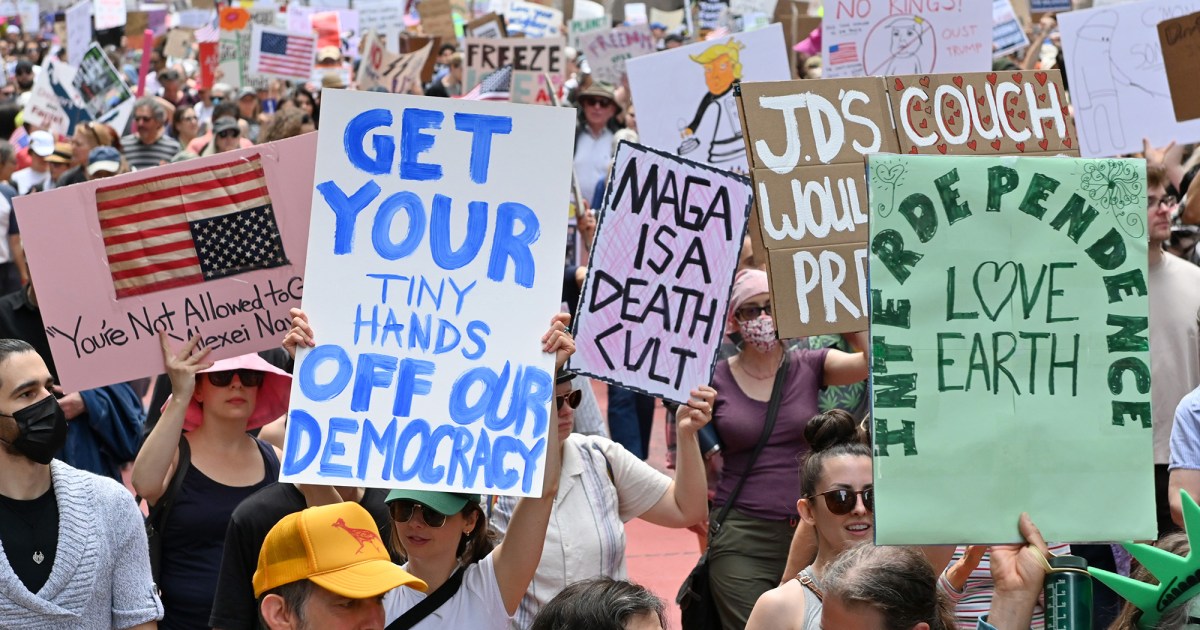This story was originally published by the Guardian and is reproduced here as part of the Climate Desk collaboration.
Hundreds of marches, pickets, and cleanup events are taking place across the US in the run-up to Earth Day on Tuesday, as environmental and climate groups step up resistance to the Trump administration’s authoritarianism and its “war on the planet.”
A fortnight after the “Hands Off” mobilization brought millions to the streets, national and grassroots organizers are teaming up with pro-democracy groups for “All Out on Earth Day”—a wave of actions to demand the right to live free, healthy lives.
In New York, thousands of people gathered in lower Manhattan on Saturday for the “Hands Off Migrants march” endorsed by dozens of climate and migrant justice groups, calling for Immigration and Customs Enforcement (ICE) to get out of New York—and New York to get out of fossil fuels. The two movements converged amid Trump’s crackdown on migrants and embrace of fossil fuels, which will drive further climate collapse and forced migration.
Meanwhile in Milwaukee, a Stop the Cuts march organized by Indivisible and 50501 called out Republican lawmakers backing the unprecedented cuts to healthcare, education, environmental protections and climate funding.
“Trump is attacking migrants and the planet by aligning himself with big oil and eroding hard won protections. Climate change is the leading cause of global displacement, these are connected issues,” said Renata Pumarol, the deputy director of the Climate Organizing Hub, which coordinated the New York march. “As we fight the authoritarianism of Trump, climate groups need to be part of the resistance because we are all under threat.”
Trump and his billionaire megadonor Elon Musk have directed the dismantling of federal offices that oversee clean air, drinking water, national parks and forests, conservation, climate smart farming, and environmental justice at dizzying speed, as well as pushing through mass layoffs at core climate and environmental agencies including the National Weather Service, Federal Emergency Management Agency, the Environmental Protection Agency (EPA) and the Forest Service.
Meanwhile, regulatory standards for fossil fuels, petrochemical plants, mining and other polluting industries have been slashed—along with an unprecedented crackdown on free speech, migrants, and universities.
Trump is also rumored to be mulling an executive order that removes tax-exempt status for some climate groups, which could prove devastating for smaller grassroots organizations. The White House is also pushing the Republican-controlled Congress to pass a budget reconciliation bill that cancels billions of dollars of Biden-era grants for clean energy and environmental protection investments.
The response from the environmental and climate movement to the Trump agenda has, until now, been mostly confined to the courts, with an array of lawsuits challenging everything from mass layoffs, suspended environmental justice funds and the erasure of climate change from federal government websites.
According to some advocates, the resistance on the streets had been somewhat underwhelming—in part down to shock at the scale and pace of Trump’s attacks, as well as efforts by some green groups to stay apolitical to appease funders and the administration. Protest fatigue, they say, may also have played a role, given that the social uprisings in response to the murder of George Floyd and Israel’s war on Gaza, which has killed more than 50,000 Palestinians, has led to little sustained political change.
Now, three months into a Trump presidency and the capitulation of Congress to his assault on the planet, many in the environmental and climate justice movement will begin rallying behind three major demands: to defend workers and democracy, lower costs for communities and end handouts for corporations and billionaires, and make polluters pay.
“The mobilizations…are the start of something: a wave from below with winnable demands to meet and inspire people where they are,” said Kaniela Ing, the national director of the Green New Deal Network, a coalition of frontline communities, labor organizers, and climate activists. “Rallies, protests, clean-ups…rising up takes many forms, and it all helps, as we need consistent mass non-cooperation to fight against authoritarianism and ensure a livable world.”
On Tuesday, the Planet over Profit and #teslatakedown coalition will picket the New York home of billionaire James Murdoch, a Tesla board member. Musk’s electric vehicle company has faced allegations of air and water pollution around its factories in the US, “and because there’s no greater threat to our ability to live rich, dignified lives on a safe, stable planet than the Trump/Musk regime,” according to organizers.
In Michigan, Jewish organizers are running a phone bank to turn out climate and environmental voters ahead of the May 6 municipal elections. In Duluth, Minnesota, traditional Ojibwe blessings for Mother Earth will open an event featuring students spearheading efforts to install solar energy in local schools and environmental scientists on the need to protect the local EPA water lab.
This year’s Earth Day, which includes climate education in schools and universities, beach-clean ups, and tree planting in the US and globally, is the 55th, but thanks to Trump, it is like no other.
The first Earth Day took place on April 22, 1970, when 20 million Americans participated in nationwide events, protests and teach-ins about pollution, the loss of wildlife, and pillaging of natural resources—bringing together disparate issues under the broad banner of what then became the US environmental movement.
This was followed with a campaign to oust 12 members of Congress with terrible environmental voting records in the midterms, with seven of the so-called dirty dozen incumbents losing their seats.
The success sent shockwaves across Washington, and a month later, Congress passed the clean air act by an overwhelming majority, followed by slew of laws that formed the bedrock of environmental protections including the Clean Water, Endangered Species, and National Marine Sanctuaries acts—and Richard Nixon created the EPA.
“For about six years the environmental movement was unstoppable, as we pushed to make the world a healthy place for humans and all diversity of life. There’s always been a pendulum in American politics but nothing like the assault on the environment—and social security, education, health and economy—we see today,” said Denis Hayes, the organizer of the first Earth Day.
“In 2026 we will need to organize aggressively for the election, but this Earth Day is about people with shared values coming together looking for local solutions, some introspection on what we did wrong that allowed Trump to get elected, and finding strategies on how to overcome him.”
A new review of 50 recent studies found that protests tend to sway media coverage and public opinion toward the climate cause—even when disruptive tactics are used. The Yale Program on Climate Change Communication researchers found that collective action can also shift people’s voting behavior. In one study in Germany, the Green Party received proportionally more votes in areas where climate protests took place, Grist reported.
The GNDN and the Sunrise Movement, a youth-led climate justice group, were among those that campaigned to secure the Inflation Reduction and Infrastructure Investment and Jobs Act in 2021 and 2022—now under threat by Trump’s pro-fossil fuel, anti-climate action agenda.
“Just three months into the Trump presidency, the damage has already been catastrophic,” said Aru Shiney-Ajay, the executive director of the Sunrise Movement. “This Earth Day, we stand united in defiance of their greed and fight for a future that prioritizes people and the planet over profits.”















